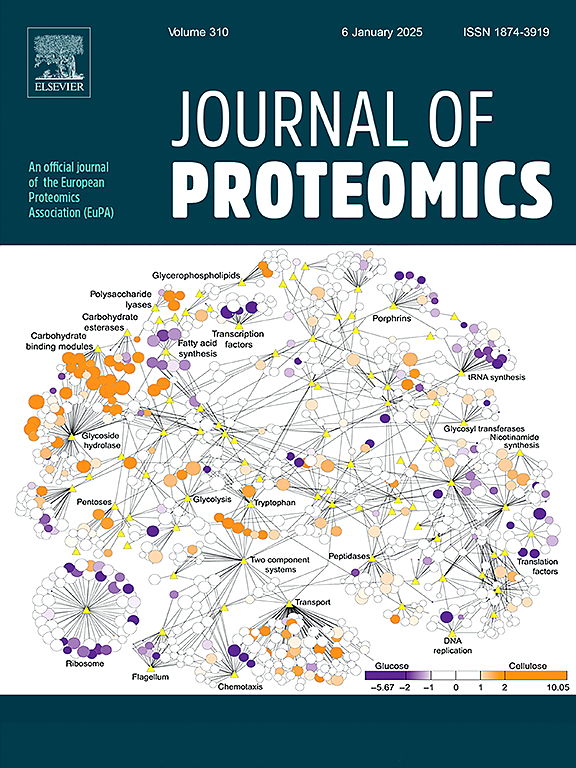嗜热纳特兰厌氧菌对个体高盐、碱性和高温的交叉和独特的胁迫适应策略
IF 2.8
2区 生物学
Q2 BIOCHEMICAL RESEARCH METHODS
引用次数: 0
摘要
嗜热奈瑟菌是第一个真正的厌氧嗜盐嗜碱菌。它采用一种独特的双重机制来适应高盐环境,同时利用“相容溶质”和“盐入”策略。然而,其对碱性pH值和热应激反应的分子机制仍不清楚。基于itraq的定量蛋白质组学分析表明,嗜热乳杆菌对三种个体极端胁迫具有交叉和独特的适应策略。本研究通过阐明以前未探索的碱特异性调节过程填补了空白。并首次对其热适应机制进行了全面分析。为了应对高盐和碱性胁迫,生物体将其代谢转向糖酵解和丙酮酸衍生的乙酸合成,以帮助满足增加的ATP需求。热休克蛋白在碱性和热适应过程中均上调,反映了“没有免费的午餐”原则。碱性pH独特地诱导DNA修复蛋白和s -腺苷蛋氨酸生物合成酶,促进质子缺乏环境下基因组的稳定性。此外,基因组紧凑以及GC含量与生长温度的正相关也可能是嗜盐和嗜碱热目Natranaerobiales的一种谱系特异性热适应。这些发现阐明了有助于解决交叉压力挑战的分层适应策略。与此同时,压力特异性重组增强了个体在极端情况下生存的灵活性。这项工作为多极端微生物的生存机制提供了新的见解,并推进了其潜在的生物技术应用。嗜盐嗜碱嗜热N.嗜热菌是生命在多种物理化学极端交叉的环境中茁壮成长的例证。然而,碱性适应的机制仍然没有充分表征,我们对热适应的理解仅限于基因组分析。本研究通过解开对高盐、碱性和热应激的反应,解决了关键的空白,从而阐明了嗜热奈瑟菌如何组织其生存策略。该研究揭示了嗜热乳杆菌采用一种策略,将保守的交叉胁迫机制与独特的胁迫适应相结合,以应对高盐度、高碱度和高温度三种不同的极端胁迫。通过确定这些机制运作的分子模块,本研究为合成生物学的未来应用奠定了基础,特别是在多极端条件下生物处理的极端微生物底盘设计方面。这些见解不仅增强了我们对多极端微生物的理解,而且为创新的生物技术解决方案铺平了道路。本文章由计算机程序翻译,如有差异,请以英文原文为准。

Cross and unique stress adaptation strategies of the polyextremophile Natranaerobius thermophilus to individual high salt, alkaline pH, and elevated temperature
N. thermophilus is the first true anaerobic halophilic alkalithermophile. It employs a unique dual mechanism for hypersaline adaptation, utilizing both “compatible solutes” and “salt in” strategies. However, the molecular mechanisms underlying its responses to alkaline pH and thermal stress remain poorly characterized. An iTRAQ-based quantitative proteomics analysis revealed that N. thermophilus used a cross and unique adaptation strategies to three individual extreme stresses. This study fills gaps by elucidating previously unexplored alkaline-specific regulatory processes. It also provides the first comprehensive analysis of its thermal adaptation mechanisms. In response to high-salt and alkaline stress, the organism shifts its metabolism toward glycolysis and pyruvate-derived acetate synthesis, helping to meet increased ATP demands. Heat shock proteins are up-regulated during both alkaline and thermal adaptations, reflecting the “No free lunch” principle. Alkaline pH uniquely induces DNA repair proteins and S-adenosylmethionine biosynthesis enzymes, promoting genomic stability in proton-deficient environments. Besides, the compact genome and the positive correlation between GC content with growth temperature may be also a lineage-specific thermal adaptation of the halophilic and alkalithermophilic order Natranaerobiales. These findings illuminate the layered adaptation strategies that help address cross-stress challenges. Meanwhile, stress-specific reconfigurations enhance flexibility for survival in individual extremes. This work provides novel insights into the survival mechanisms of polyextremophiles, as well as advancing their potential biotechnological applications.
Significance
Halophilic alkalithermophile N. thermophilus exemplify life's capacity to thrive in environments where multiple physicochemical extremes intersect. However, the mechanisms underlying alkaline adaptation remain inadequately characterized, and our understanding of thermal adaptation is limited to genomic analyses. This study addresses critical gaps by disentangling the responses to hypersaline, alkalinity, and thermal stress, thereby elucidating how N. thermophilus organizes its survival strategies. This research reveals that N. thermophilus employs a strategy that combines conserved cross-stress mechanisms with unique stress adaptations to cope with the three distinct extreme stresses of high salinity, alkalinity, and temperature. By identifying the molecular modules through which these mechanisms operate, this research sets the stage for future applications in synthetic biology, particularly in the design of extremophile chassis for bioprocessing under multi-extreme conditions. These insights not only enhance our understanding of polyextremophiles but also pave the way for innovative biotechnological solutions.
求助全文
通过发布文献求助,成功后即可免费获取论文全文。
去求助
来源期刊

Journal of proteomics
生物-生化研究方法
CiteScore
7.10
自引率
3.00%
发文量
227
审稿时长
73 days
期刊介绍:
Journal of Proteomics is aimed at protein scientists and analytical chemists in the field of proteomics, biomarker discovery, protein analytics, plant proteomics, microbial and animal proteomics, human studies, tissue imaging by mass spectrometry, non-conventional and non-model organism proteomics, and protein bioinformatics. The journal welcomes papers in new and upcoming areas such as metabolomics, genomics, systems biology, toxicogenomics, pharmacoproteomics.
Journal of Proteomics unifies both fundamental scientists and clinicians, and includes translational research. Suggestions for reviews, webinars and thematic issues are welcome.
 求助内容:
求助内容: 应助结果提醒方式:
应助结果提醒方式:


